The HTC 10 Review
by Joshua Ho on September 19, 2016 8:00 AM ESTLatency with Google WALT
One of the major points of differentiation with the HTC 10 is supposed to be smoothness. This, more than anything was something that HTC emphasized repeatedly in their initial introduction of the HTC 10. This phone is supposed to be smooth in a way that most of the Android competition isn’t. It’s really kind of disappointing to me that there isn’t a lot of information in the public domain testing HTC’s claims.
So in the interest of testing this out, I managed to get a WALT device working. What's WALT, you may ask? It's an internally developed Google toolset and hardware device combination to measure touch latency on Android (and Chromebook) products. By combining some simple external sensors connected to a Teensy board with the appropriate software to measure those sensors, WALT makes it possible to directly measure several forms of touch and audio latency of an Android device. Normally this would require a high-speed camera, but Google has developed WALT as a more practical alternative, internally validatating the product against said high speed footage.
To start we can look at tap latency and screen response time. Combining these two figures together will give us the total time it takes at minimum for the device to respond to a tap. It’s worth noting here that there is an upper bound to screen response time because devices are generally locked to 60 Hz and triple buffering means that our response time at best can be 48 ms. The screen response time figure is dominated by this latency in almost all cases, with some extra overhead for the panel’s native response time and some OS overhead can be involved as well.
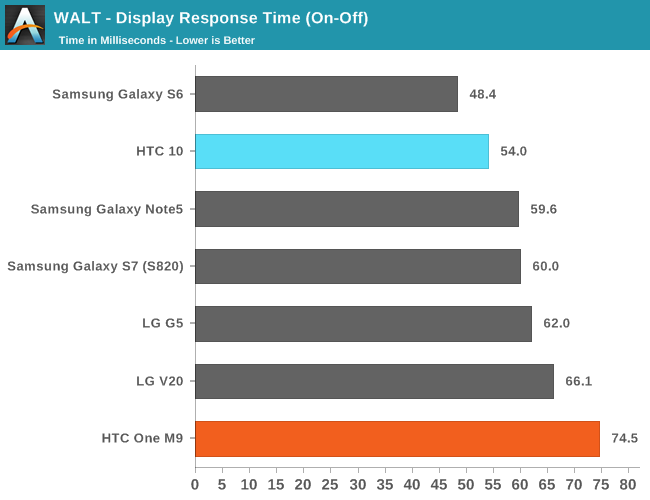
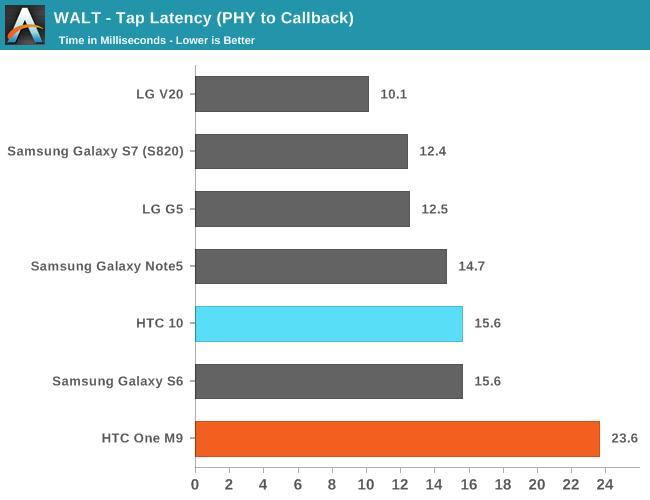
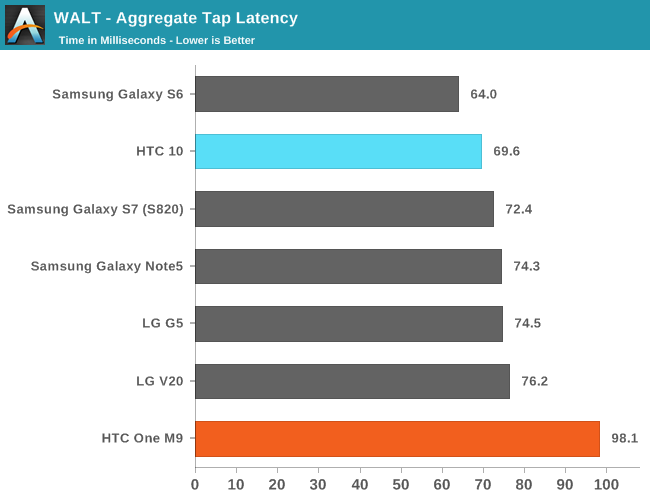
In tap latency the HTC 10 performs fairly well but everything is so close here that I'm not sure it really matters. In the interest of trying to see what exactly HTC was trying to highlight I also went ahead and used the drag latency test to try and see if this was a notable point of differentiation.
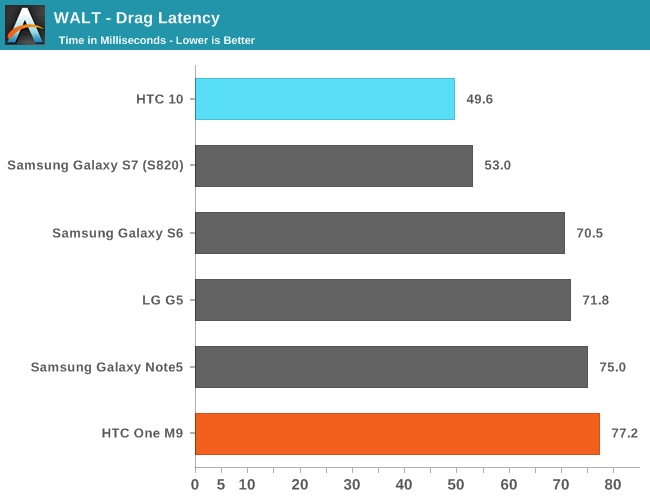
While I would say that WALT's drag latency test seems to be highly unreliable and I'm kind of questionable on whether these results can really be trusted, there's definitely a noticeable difference in how quickly the HTC 10 responds to a swipe compared to most of the competition. The Galaxy S7 seems to keep up which is kind of surprising. I suspect that most of the difference in response between the two devices is the momentum given to a swipe rather than the actual latency.
Misc
With every review there are a lot of little things here and there that I end up discovering along the way that are interesting and worth discussing, but often cannot be discussed in a section of its own, but there are definitely things that have managed to grow past this section into their own as noteworthy.
One of the first places to start is the GNSS of this phone. I’m not sure what exactly HTC did here, but it’s remarkably fast and high quality. When connected to a network A-GPS through the cellular modem (Qualcomm gpsOne) allows for near-instant locks, but I managed to achieve a true cold lock in 1 minute and 6 seconds and it reached a precision of 13 feet within 10 seconds after initial position fix. Precision seems to be as high as 10 feet, which is pretty much the lower bound of what GPS can do without differential GPS systems which allow for precision down to about 10 centimeters.
In addition to GPS reception for whatever reason the HTC 10 seems to have noticeably good reception on AT&T LTE in the SF Bay Area and Los Angeles. It was not unusual for me to see the One M7 sitting on HSPA+ while the HTC 10 would still be on LTE. Of course, I don’t have any formal testing to back this claim up but generally speaking I saw anywhere from 3 to 6 dBm of difference in received power in favor of the HTC 10.
As far as design wins go, ST-M takes the design win for the laser auto-focus sensor, Synaptics is used for the touchscreen, Cypress CapSense Cy8C PSoC is used for the capacitive buttons, an NXP TFA9888 amp is used for the speakers, NXP PN544 is used for NFC, and an Analogix chip is used to enable the USB-C port. It’s identified only by the codename Ohio, but it’s fairly likely that this is the ANX7418. There’s also an ANX7816 for 4K30 over SlimPort. Looking at the SPI bus, for some reason there’s a Micrel KS8851 Ethernet MAC controller and HTC’s custom MCU which is referred to as CwMcuSensor. There’s also an Fingerprints FPC1155 for the fingerprint scanner, and an AK8789 hall sensor.
HTC claims that audio is over a separate DAC and amp, but I really can’t find any evidence that the HTC 10 has a DAC outside of the Snapdragon 820 in the system files, namely the WCD9335. Regardless, the speakers on the HTC 10 are a lot better than most other Android phones on the market. They’re still a step down from the One M9 or M8, but they do provide a fairly convincing stereo effect if you turn it on and overall quality is acceptable. I’m not exactly an audiophile but music over the 3.5mm jack didn’t have any noticeable issues like hissing or popping or anything strange like that.


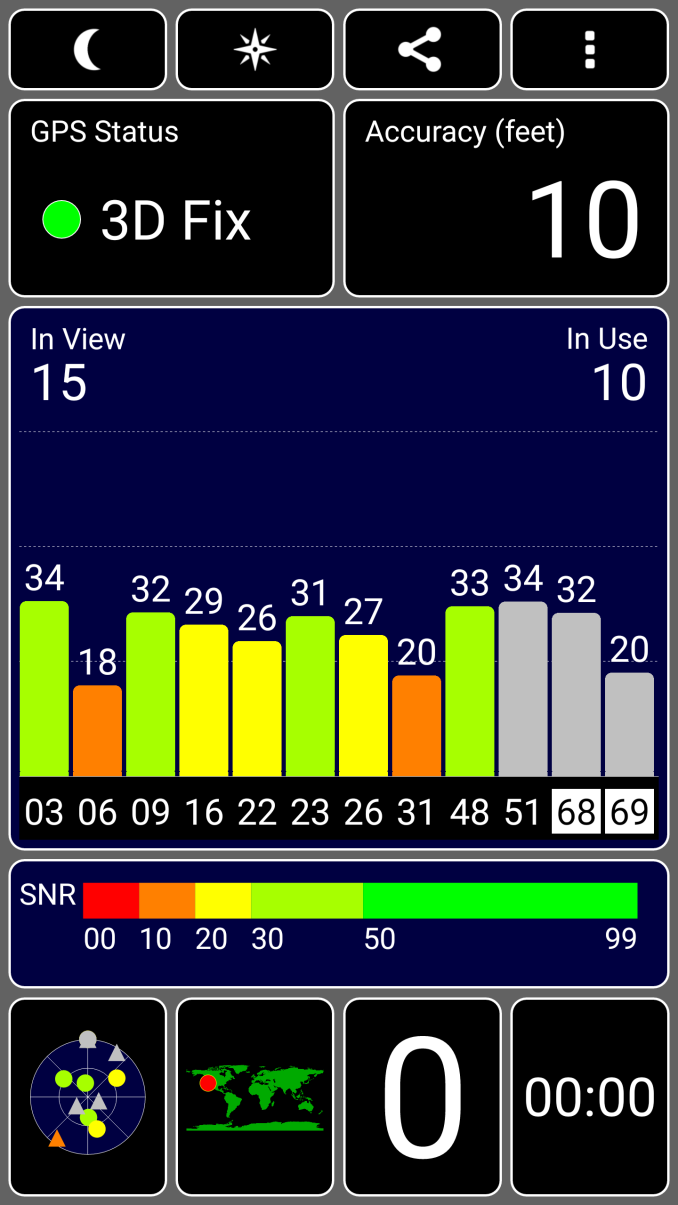








183 Comments
View All Comments
invinciblegod - Monday, September 19, 2016 - link
I guess you mean looks similar spec wise because it looks nothing like an S7 appearance wise (especially with that weird super chamfer).Meteor2 - Monday, September 19, 2016 - link
HTC's software is far better than Samsung's. That alone puts it ahead of the S7.TheinsanegamerN - Monday, September 19, 2016 - link
A surprising number of people *like* touchwiz for some unknown reason.darkich - Tuesday, September 27, 2016 - link
Multi window!It's by far the best multitasking you can find in any mobile platform, especially on the Galaxy Note devices, where it can basically intuitively, simply and easily do a pc-grade windowing without any issues.
Only thing it can't do is minimizing a game within a window (pointless anyway).
The other feature is screen minimizer which allows easy one handed usage for even the biggest phones.
Impulses - Thursday, September 22, 2016 - link
If I HAD to buy a device over the last six months I would've gone right for the 10, I think it was largely viewed as a totally viable alternative to the S7 by most objective eyes... I'm holding off for the smaller Pixel tho, hoping it doesn't disappoint.Never owned a phone anywhere near as long as I've owned this Nexus 5, and I'm still reluctant to go to a larger device (Sony Z3c is the only other phone to remotely tempt me besides the 10).
damianrobertjones - Monday, September 19, 2016 - link
Dear HTC,Why not try something different? Release 5 Windows Mobile 10 based handsets (Just after MS announces their Surface Phone).
It's worth a shot.
Murloc - Monday, September 19, 2016 - link
the problem with that idea is that WP is dying.Nokia tried doing that and their phone business is currently dead.
WP10 even broke the lockscreen background-changing feature because it was made dependent on silverlight and then they killed silverlight.
Funnily enough, Edge and windows phone internet explorer don't even support silverlight.
The lack of mass market adoption killed app availability, most new apps don't support it, the big ones that do receive updates much later.
Google made sure that no decent youtube app is available too.
ToTTenTranz - Monday, September 19, 2016 - link
Every single windows phone from the last 10 years has resulted in millions of losses but you think the next one is going to work out well because...?eSyr - Monday, September 19, 2016 - link
It would be nice to have comparison to m8 also, since many m8 owners just skipped m9.Badelhas - Tuesday, September 20, 2016 - link
I agree. I am still rocking the M8 and love it.Great review, though!